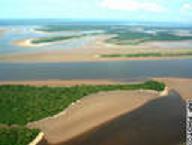Brazil's Amazon region suffering worst drought in 40 years
 While hurricanes thousands of miles away battered the United States and the Caribbean with water and wind, the residents of this fishing town in the deep Amazon watched the lake they depend on for food and transportation shrivel away.
While hurricanes thousands of miles away battered the United States and the Caribbean with water and wind, the residents of this fishing town in the deep Amazon watched the lake they depend on for food and transportation shrivel away.
Hundreds of thousands of Brazilians across seven states have been hit this year by the Amazon region's worst drought in four decades, the result, meteorologists say, of warmer ocean water, which also is being blamed for one of the most violent hurricane seasons on record around the Gulf of Mexico.
The summer rains have begun here, but it remains to be seen whether enough water will fall to restore the rivers.
The drought has been so severe that Manaquiri was overwhelmed last month by the smell of rotting fish littering the exposed lakebed until the residents of the 14,000-person town gathered them for disposal.
Boats that had brought people and produce from other river communities lie scattered on dry land. Malaria, which is common in the area, has proliferated as retreating waters leave stagnant pools behind, ideal for breeding mosquitoes. A federal health worker said low river levels had cut him off from stricken jungle towns.
Environmental activists said several children already had died from common diseases aggravated by the drought.
"We can't live like this," said Wanderclia da Silva, a farmer who used to spend just three hours by boat to reach Manaquiri from her community. Her most recent trip took an entire day of canoeing and then walking. "If this continues, we won't be able to live here anymore."
The drought has been most intense around Amazonas state's biggest city, 1.6 million-person Manaus, where cruise ships heading for the Atlantic have been forced to dock far from the urban waterfront, which has been reduced to barren earth covered in heaps of trash. Residents have taken to calling the riverfront the "naked port."
"Business has dropped because many of the boats can't come in," said Raimundo Nonato de Oliveira, who runs a restaurant in Manaus on the banks of the Black River. "People here haven't seen anything like it before."
Scientists say the drought is part of a climatic shift that's overturned the lives of millions around the Western Hemisphere this year.
Water temperatures in the North Atlantic and the Gulf of Mexico have been as much as 3.6 degrees higher than normal this year. That helped feed the hurricanes that devastated the U.S. Gulf Coast and the Caribbean.
It also helped generate warmer-than-normal air currents that poured into the Amazon basin and prevented rain clouds from forming, said Edvardo Souza, a meteorologist with a Brazilian agency that monitors conditions in the Amazon forest.
Originally covering more than 2 million square miles, the Amazon is the world's largest tropical rain forest.
The last time the Amazon felt such withering conditions was in 1963, Souza said. Less-severe droughts have hit parts of the Amazon twice over the past decade during the annual dry season, which runs from July to September.
This year, some towns, such as Tabatinga near the Colombian and Peruvian borders, received only a fifth of their normal rainfall. Water levels on the Amazon and other rivers have dropped by as much as 33 feet.
The environmental activist group Greenpeace warns that this year's experience could be a sign of things to come if practices such as deforestation and emissions of heat-trapping gases into the atmosphere don't stop.
"Deforestation has had a big role in what has happened," said Carlos Ritto, the coordinator of Greenpeace's Brazilian climate campaign, who noted that water emitted by plants accounts for about half the Amazon's vapor. "Unless we stop these trends, this scenario will become much more frequent."
Souza is hesitant to link deforestation or global warming to this year's drought, however, calling such theories speculative.
What isn't speculative is what the past few months have brought here.
Farmer Horace de Almeida Ramos, who lives in the river community of Nova Cara, or New Face, hopes the rains will come soon so that he, his wife and five young children will be able to leave Manaquiri. They've been here for about a month, their boat stranded by low water.
The sparse rainfall also devastated his crop of manioc root.
"This has been a rough year," he said, looking over the narrow stream coursing down the middle of Manaquiri's lakebed, now covered by grass. "We just want to get back home and move on with our lives."
Souza said cooler water in the Pacific Ocean probably would bring seasonal amounts of rain to the Amazon and restore water levels within a month. By late October, rain already had started falling and had filled some empty waterways.
Aid workers from Amazonas state, working with the Brazilian air force, have delivered food and other goods to about 150,000 stranded people in 2,471 communities since the worst stages of the drought began in mid-October.
Over the next several weeks, much of the effort, dubbed SOS Interior, will be shifting to Para state downriver, where the drought is heading.
Even if the rains restore the waterways, there's uncertainty about what the long-term effects might be.
"We don't know how long it will take for these communities to return to normal," said local sociologist Wikins Roque, who's been working with relief efforts. "The fish have all died, and crops have been lost. The effects of this drought don't stop with the rains."
(Published Knight Ridder Washington Bureau, November 2, 2005)
____________________________________